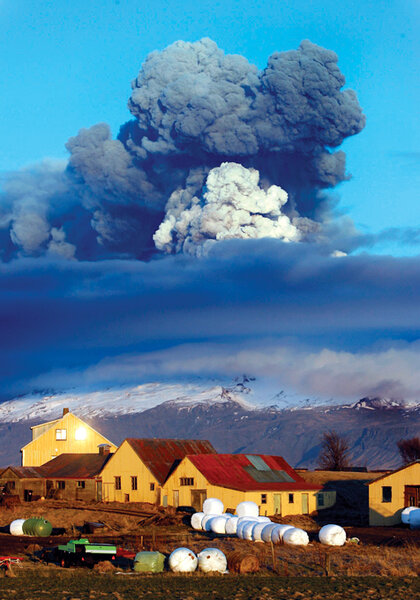Wait, bananas grow in Iceland?!
Loading...
Like the rest of the world, I was captivated by the images of the eruption of the Eyjafjallajökull volcano in Iceland. That such a tiny country could put forth so robustly, extending its influence over a large chunk of the known world like the Vikings of yore, was an ungentle reminder that nature will have its way, while we are rendered little more than onlookers.
I long ago became intrigued by Iceland, by the idea of a tiny population – currently 300,000 souls – eking out a prosperous (some might say preposterous) existence on a far-flung island riddled with volcanoes, racked by earthquakes, and whipped by brutal winds. Legend has it that one of the early settlers, Erik the Red, called the place "Iceland" to make it sound forbidding to his Norwegian pursuers. Be this as it may, for me it's the fire, rather than the ice, that makes Iceland such a kick. Let me count the ways.
When I first traveled to Iceland back in the 1980s, the first thing that caught my eye – after the frozen lava field surrounding the airport in Keflavík – was a plume of steam in the distance. My investigation brought me to the Blue Lagoon, a geothermal lake designated by the Icelanders as a sort of spa. I couldn't resist taking a dip in the mineral-rich waters that had bubbled up from the recesses of the earth, heated by the primal fire. This while a squall brought in a flurry of snow, as if to remind everyone that this was, indeed, the subarctic.
Iceland benefits, if that's the word, from its precarious position atop the mid-Atlantic ridge, a suboceanic mountain range and crack in Earth's crust that marks the boundary between the European and North American tectonic plates. This means that Iceland, geologically speaking, is being pulled apart. It's also what makes Iceland one of Earth's "hot spots." I took advantage of this, in an impromptu manner, during a subsequent visit. I had been invited by friends to attend a horse show in the far north. Although it was June, it was cold and windy. As horse after horse strutted its stuff against a dramatic backdrop of barren, sweeping slopes; green fields; and a distant glacier, I grew increasingly uncomfortable and began to shiver. Finally, in desperation, I lay down and curled up in the grass. Within minutes I could feel it. Warmth. But it was not coming from me. It was seeping up from below. The same fires that were tearing the island in two were warming one human body. A small gift from a tectonic giant.
The most poignant interaction I had with Iceland's fire was on a day trip with an Icelandic friend. As we drove the rough, hard-packed dirt road east from the capital, he pointed out a rise of steam in the distance. "That's Hveragerdi," he said. "An important farming town." Farming town? In Iceland? Well, there were no amber waves of grain, but there were greenhouses that grew tomatoes, peppers, and cucumbers, among other delights. These were built over steam vents, harnessing the free energy to allow the propagation of these otherwise impossible crops.
On the day we visited we saw a burning pile of bananas outside one of these greenhouses. "Have you ever seen such a thing?" asked my friend as we averted our noses from the stench. "No," I said, "but in America there's a famous book that describes the burning of grapes during the Great Depression because the price had fallen so low that it was cheaper to destroy them."
"Yes, yes," said my friend, making a connection. "That's the way it is here. The price of bananas has collapsed, so the farmers are burning them to create a shortage."
I nodded gravely, wondering if John Steinbeck would have recognized these as Iceland's bananas of wrath.
After our journey we returned home through a driving rain issuing from impenetrably gray, roving skies. My friend's home in Reykjavík, like all others in the capital, was heated by geothermal energy. We sat down at his table and enjoyed hot tea and a heavy, sweet, dark bread. "This is delicious," I remarked. "Did you bake it yourself?"
"No," he said. "It comes from Hveragerdi. They put the dough in the ground and the fires of the earth bake it overnight."
Of course. It made perfect sense. In Iceland, that is.






